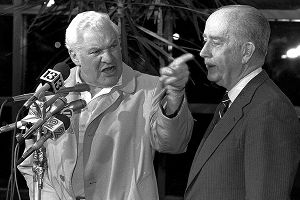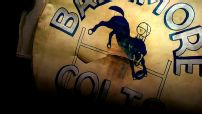...no, not Sgt. Pepper. Thirty years ago today, in the dead of night amidst a late season snowstorm, the worst thing that could ever happen to a Baltimore Colts fan happened - Robert Irsay took the team, along with it's colors and history, to Indianapolis.
Irsay acquired the Colts in 1972 after buying the then Los Angeles Rams and trading them for the Colts that same day. The Colts were an impressive franchise back then. The team sold out 51 straight games in the 1960s and won the Super Bowl in 1971. During Irsay’s first year of ownership, attendance averaged at more than 60,000 fans. But that would change.
Irsay fired the coach who had won the Super Bowl just two seasons earlier and later traded away the legendary Johnny Unitas. Irsay’s decisions damaged the team’s reputation to the point where, in 1983, the Colts drafted John Elway—the top college draft pick then—but he refused to sign. Instead, he said he’d rather play baseball for the Yankees. That forced Irsay to trade Elway to the Denver Broncos, where he became one of the best NFL quarterbacks of all-time.
By the time the Colts left Baltimore, the team had six straight losing seasons. Attendance had plummeted to an average of only 42,000 fans per game. As sportswriter Frank Deford put it, “A man who could screw up professional football in Baltimore would foul the water at Lourdes or flatten the beer at Munich.”
During this decline, Irsay repeatedly flirted with moving the team to Phoenix, Memphis, Los Angeles, Jacksonville and Indianapolis, all while emphatically denying he was going to leave.
On March 27, 1984, the Maryland Senate voted 38 to 4 to approve legislation, which would allow Baltimore to seize the team.
Many of those who face eminent domain can’t pack up their homes and businesses and skip town. But Irsay could. The very next day, he called Indianapolis Mayor William Hudnut and told him the Colts were moving to Indianapolis.
Upon hearing the news, Mayor Hudnut called his neighbor, who owned Mayflower Transit, to send 15 trucks, free of charge, to the Colts’ facilities in Owing Mills, Md. Late Wednesday night, the vans pulled in. In the midnight hours, the team gathered everything they could and loaded the trucks as quickly as possible.
Many staffers and players weren’t even informed the Colts were breaking away. According to one employee, after the move, “everything was gone…not a piece of paper or a trash can was left.”
To avoid arousing suspicion and to evade any Maryland police, each truck tookdifferent routes out of the state. When the sun dawned on March 29, the team was gone. Once the trucks reached the Indiana state line, Indiana state troopers escorted the convoy to Indianapolis.
To avoid arousing suspicion and to evade any Maryland police, each truck tookdifferent routes out of the state. When the sun dawned on March 29, the team was gone. Once the trucks reached the Indiana state line, Indiana state troopers escorted the convoy to Indianapolis.
The move stunned Baltimore Colts fans. Mayor Schaefer cried when he found out the Colts absconded. Some fans bought “Bob Irsay Sucks” t-shirts. Mayflower trucks were boycotted in Baltimore and vandalized. One Maryland resident even wrote to Mayor Hudnut asking him to change the name of an Indianapolis street from “Maryland” to “Irsay:” “We in the great state of Md., do not want your city to have our state’s name on your streets…You owe us one.”
Just hours after the team had left, Maryland’s governor signed the eminent domain bill on March 29. The next day, with this new power, the city began condemnation proceedings against the Colts.
Meanwhile, Indianapolis was ecstatic. On April 2, 20,000 fans, including Hudnut, Irsay and U.S. Senator (and future Vice President) Dan Quayle, attended a welcoming ceremony for the Colts at Hoosier Dome. Ticket demand was high. For every season ticket, the Indianapolis Colts received nearly three requests. Hudnut later described delivering the Colts to Indianapolis as “the most exciting part” of his four terms as mayor.
A year-and-a-half after the midnight move, a federal judge dismissed the case in December 1985, ruling that Baltimore “lacks the power to condemn the Colts’ franchise… the Court concludes that the Colts were ‘gone’ on March 30, 1984.” Crossing state lines let the team escape Baltimore’s power of eminent domain. Tellingly, the team did not challenge the condemnation as an inappropriate “public use.” In March 1986, Hudnut announced a settlement between the two cities. Litigation cost $400,000 for Indianapolis and racked up half a million dollars in legal bills for Baltimore.
Even after the Colts left, Charm City’s passion for football never died. The city hosted teams from both the short-lived United States Football League and, rather surreally, the Canadian Football League. For a dozen years, the Baltimore Colts Marching Band continued to play on and even performed at other NFL teams’ halftimes, as shown in the ESPN documentary The Band That Wouldn’t Die. Finally, after a dozen years of waiting, Baltimore became home once again to an NFL team, the Baltimore Ravens in 1996, after Art Modell relocated the Cleveland Browns.
30 years on, Baltimore better without Colts
March, 28, 2014





No comments:
Post a Comment